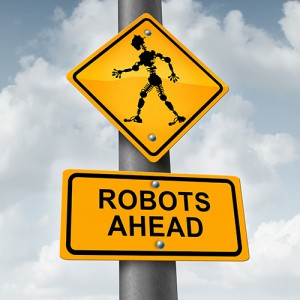 I grew up watching robots on television, among them B9 from “Lost In Space” and Rosie the Robot from “The Jetsons.” I thought such humanoid robots were already in use or at least were just around the corner. Such was the power of television working on a young mind. Here we are decades later and while we have utilized industrial robots for many years, the development of a humanoid robot is still in its infancy. What exactly do humanoid robots look like now and how close are they to the ideal Rosie? More importantly, how will we react to these machines as they come close to replicating or surpassing human capabilities?
I grew up watching robots on television, among them B9 from “Lost In Space” and Rosie the Robot from “The Jetsons.” I thought such humanoid robots were already in use or at least were just around the corner. Such was the power of television working on a young mind. Here we are decades later and while we have utilized industrial robots for many years, the development of a humanoid robot is still in its infancy. What exactly do humanoid robots look like now and how close are they to the ideal Rosie? More importantly, how will we react to these machines as they come close to replicating or surpassing human capabilities?
From NAO to Pepper
Aldebaran, a French company that is now a subsidiary of Japanese conglomerate Softbank, first created the NAO robot in 2006. This humanoid robot was designed to educate students at different levels. In primary education, they work well with young learners and even learners with disabilities. They can help teach simple skills, such as counting or the ABCs, and are encouraging without judging. NAO can be used with secondary and even university students to introduce programming and robotics. This is a very real way to get feedback on successful coding and motion engineering projects. Working with this robot could stimulate the visual, auditory, tactile, and even kinesthetic learner.
Pepper, also from Aldebaran, is billed as the “robot that understands your emotions.” Pepper has multiple microphones and high definition cameras in order to make sense of its surroundings, plus an array of sensors and fine motors. It is programmed to perceive and analyze emotions and to get to know a person. It has been used to work with children and adults with autism to help them develop coping mechanisms and understand their own emotions when working through problems. It also comes with a built in tablet so that it can convey its own emotions. It has a wireless internet connection so it could be a Siri or Alexa substitute, providing information in android form instead of a smartphone or speaker. Pepper has motion sensors and collision detection systems so it could be programmed to vacuum the house or walk the dog. Just remember to dress it in a raincoat before it goes out.
Human-Robot Interaction
The Aldebaran machines are cute and they promote social interaction but there still seems to be a general angst towards functional robots, particularly those that take on humanoid form. A recent Discover magazine article speculated that the stigma stems from science fiction stories, or even the old “Terminator” movie series, about robots that suddenly take on very dark and dangerous human thought. Another concern is that robots will take over our jobs as opposed to simply assisting us with difficult and dangerous tasks. Some industrial robots have already done just that and there is fear that it will continue. Google reportedly has decided to sell its 2013 Boston Dynamics acquisition, partly due to social reaction to their humanoid robot development. There appears to be a very fine line between cute, helpful robots and threatening robots.
Thoughts
I would love to hear your thoughts on humanoid robots. Can we overcome our fears and social stigmas to welcome them into our environment, or have we created an artificial intelligence that is too close to human thought and emotion? I think we need to face the challenges, real or perceived, before we can move on and figure out how to improve our own productivity and human existence. Let me know your thoughts.
Kelly Brown is an IT professional and assistant professor of practice for the UO Applied Information Management Master’s Degree Program. He writes about IT and business topics that keep him up at night.


